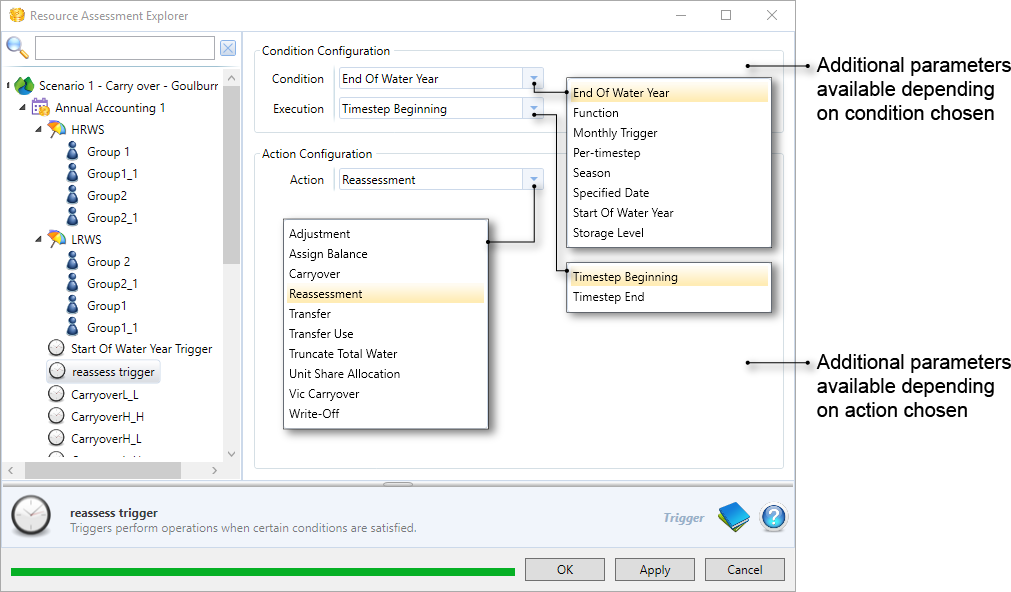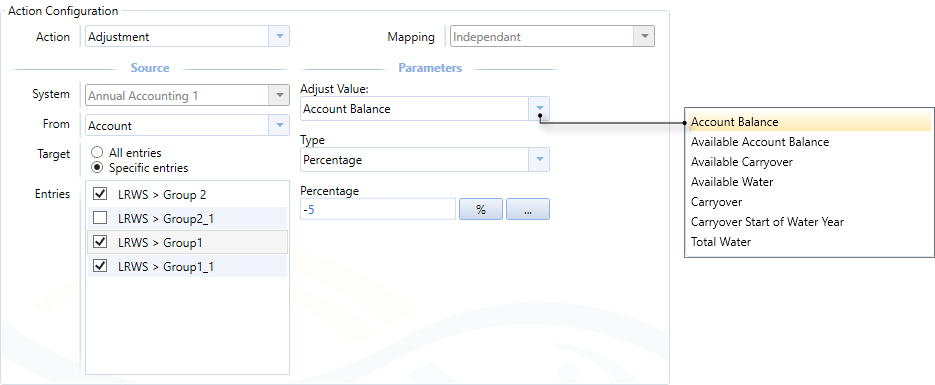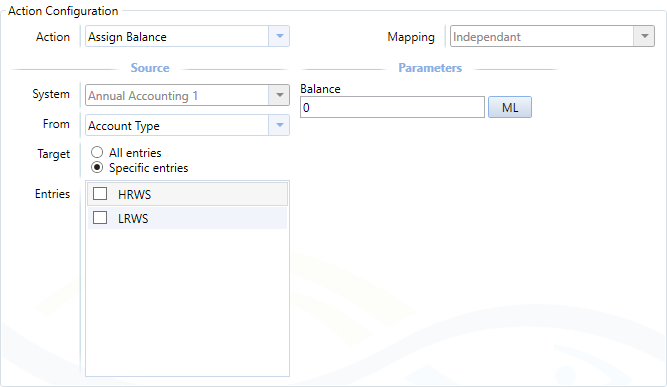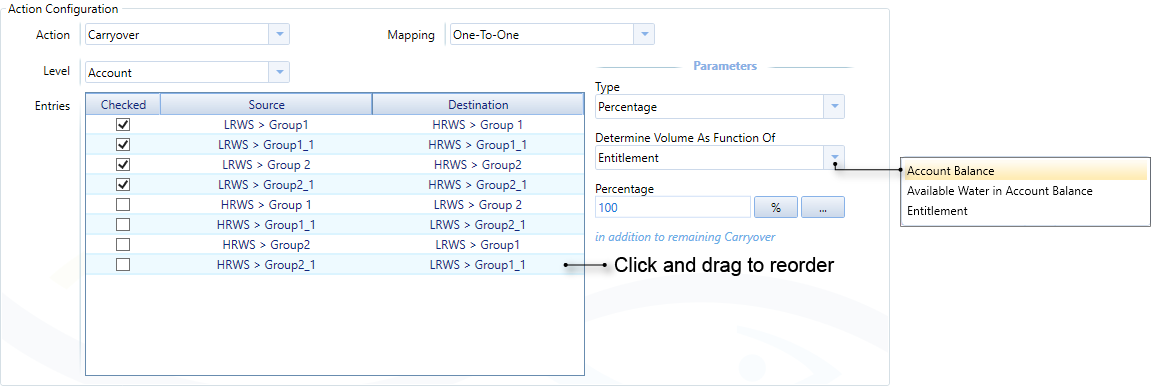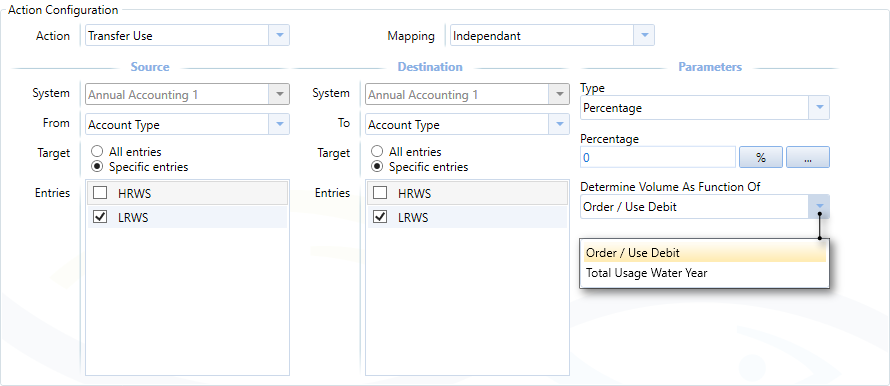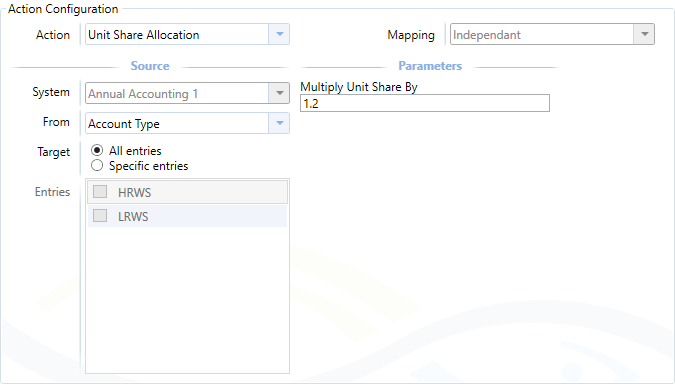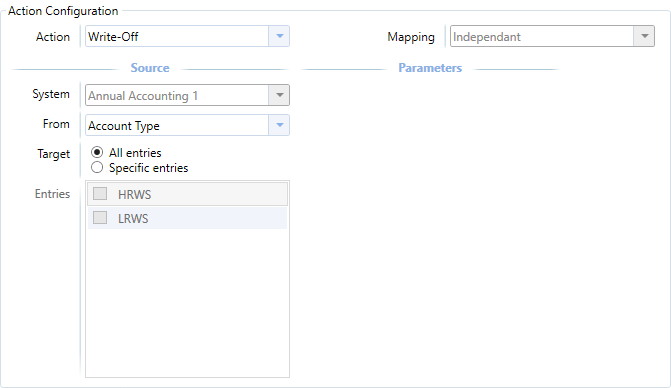Note: This is documentation for version 4.11 of Source. For a different version of Source, select the relevant space by using the Spaces menu in the toolbar above
Types of triggers
Triggers are used to initiate or cancel certain actions for an account, account host, account type or system in a resource assessment system. This page provides details of the different types of triggers available in Resource Assessment systems, along with types of actions that can be initiated.
Figure 1 shows the general layout of triggers in the Resource Assessment Explorer.
Figure 1. Triggers, general layout
Adding a trigger
To add a trigger, right click on an annual accounting system, the account type or account and choose Add trigger. You can rename or delete an existing trigger by right clicking the trigger and choosing the appropriate context menu option.
As shown in Figure 1, configure the following parameters for each trigger:
- Condition - the type of condition that will trigger the action. The parameters displayed in the Condition Configuration panel will change depending on which condition is chosen, see Table 1.
- Execution - when to execute the trigger (either at the beginning or end of the time-step). You can also prioritise the order of triggers relative to each other on the Trigger Priority tab for the annual accounting system, see Annual Accounting - Trigger Priority.
- Action - the action to occur as a result of the trigger condition being met. The Action Configuration panel will change depending on what action is chosen. See Trigger actions.
Table 1. Types of conditions
| Condition | Description |
|---|---|
| End of water year | Triggers an action at the end of the water year. |
| Function | Triggers an action using a defined function. The format of a function should be as follows: if( A > B,1,0), where “1” indicates the action will occur and “0” means the action will not happen. |
| Monthly trigger | Tiggers an action for a particular month. You must specify whether to offset from the start or end of the month, along with the number of days. |
| Per-timestep | Triggers an action per a specified number of time-steps. For example, if a monthly model, triggers an action per month or per several months. You can choose to reset the repeat interval at the start of each water year. |
| Season | Triggers an action for a specified season. You must define and start and end dates. |
| Specified date | Triggers an action on a specified date. |
| Start of water year | Triggers an action at the start of the water year. You can choose to repeat the action at a specified number of timesteps, and whether to reset the repeat interval at the start of each water year. |
| Storage level | Trigger based on a specified storage level. You must specify the storage, the level and whether the level is rising or falling. |
Trigger actions
There are a total of nine trigger actions available in Source (Figure 1), each having an individual set of definable parameters. All triggers can be applied at the system, account type, or account level. The exceptions are the reassessment and the Vic Carryover triggers, which are available at the system level only.
Once an action is selected, action-specific parameters are displayed. The general process of configuring an action is:
- Select a Source, that is, the account type(s), account(s) or account host(s) that the trigger applies to. The sources available depend on the level that the trigger is applied at. At the system level, all sources are available. At the account type level, you can select an account or account type, and at the account level you can select an account.
- For Carryover, Transfer and Transfer Use triggers, select a Destination system, and account type(s), account host(s) or account(s). For these triggers, you can select sources and destinations using Independent or One-to-One Mapping, see Carryover.
- Define parameters unique to that action (see each trigger, below). When a trigger has a Type parameter, you can select percentage or volume.
Many actions affect or are affected by a user-configureable model parameter, such as Account Balance, Carryover or Entitlement, these are defined in Table 2.
Note: When spillable water has been configured and is available to the accounts, the status of that water is maintained during the trigger action.
Figure 1. Example Trigger, Carryover with independent mapping
Table 2. Triggers, model parameters
| Parameter | |
|---|---|
| Account Balance | The remaining volume/proportion of water available to an account (not including carryover). |
Carryover | The remaining volume/proportion of water available to an account that was carried over from the previous water year, ie. carryover balance. |
| Carryover Start of Water Year | At the start of the water year, the volume of water carried over from the previous water year. |
| Entitlement | Annual volumetric entitlement for an account. |
| Total Water | Account Balance + Carryover Balance. |
Available Water in Account Balance, or Available Account Balance | For Annual Accounting systems with Carryover Type set to Spillable and Water Available While Spillable disabled*: Max(0, Account Balance - Max(0, Spillable Water - Carryover Balance) - Minimum Balance) Else: Max(0, Account Balance - Minimum Balance) |
| Available Carryover | For Annual Accounting systems with Carryover Type set to Spillable and Water Available While Spillable disabled*: Max (0, Carryover Balance - Spillable water) Else: Max (0, Carryover Balance) |
| Available Water | For Annual Accounting systems with Carryover Type set to Spillable and Water Available While Spillable disabled*: Max(0, Account Balance + Carryover Balance - Spillable Water - Minimum Balance) Else: Max(0, Account Balance + Carryover Balance - Minimum Balance) |
| Order / Use Debit | Water debited from an account that time step. |
| Total Usage Water Year | Water debited from an account since the start of the water year.. |
*These options are configured at the Account Type level on the Carryover tab, see Annual Accounting - Carryover.
Adjustment
This trigger adjusts one of several parameters (eg. account balance, available water) based on a specified percentage or volume. The available parameters that can be adjusted are shown in Figure 3, see Table 2 for explanations. A positive value indicates an addition; a negative values represents a deduction. The example shown in Figure 2 represents an evaporation loss of 5% of available water. This will reduce 5% of available water, so 95% of available water is left in available water balance.
Priority
When adjusting from available water, the priority specified for the account in the water user node (the Priority field as shown here) is used to determine the order that the accounts are deducted from, with the highest priority (lowest number) deducted from first. For crediting (ie. incoming water), specify the account you want to hold the water in. The priorities in this case would be in the reverse order to which they appear in the water user node.
For example, consider a water user with one account and a carryover; the priority of use is carryover first, then account balance. This trigger then deducts the desired volume from carryover first; if insufficient water is available, the residual is subtracted from the account balance.
Spillable Water
When the adjusted model parameter has spillable water:
- For a percentage adjustment, both spillable water and the remaining water are simultaneously adjusted by the specified percentage.
- For a volumetric adjustment, the adjustment will be applied first on spillable water and then the remaining water.
Figure 3. Adjustment trigger
Assign balance
As its name suggests, this trigger assigns the account balance to a specified volume (Figure 4). The original account balance will be replaced by the new assigned value. This can be done for account type(s), account host(s) or account(s).
Figure 4. Assign balance trigger
Carryover
A specified proportion or a certain amount of water can be carried over from an account type, account host or account to another account type, account host or account within the same or another accounting system (Figure 1, Figure 5). This is in addition to the water in the carryover account balance, which is automatically carried over. When Type is percentage, the percentage of water to be carried over can be calculated as a function of Account Balance, Available Water in Account Balance or Entitlement (Figure 5), see Table 2 for definitions of these model parameters.
This trigger is usually set at end of water year to carry over unused water from previous water year to the next new water year.
Figure 5. Carryover trigger
Mapping
For Carryover, Transfer and Transfer Use you can choose between Independent or One-to-One Mapping. This affects how the Source and Destination accounts, account hosts or account types are transferred between.
Independent mapping (Figure 1, Figure 6) allows you to map between accounts, account types or account hosts to other accounts, account types or account hosts within or between accounting systems. Note that the Source system will always be the system in which the trigger is located. The source and destinations do not need to be the same level - eg. an account type can be mapped to two accounts in another accounting system (Figure 1).
One-to-one mapping (Figure 5) allows you to map accounts, account types or account hosts to others of the same level - eg. you can map an accounts to other accounts. This allows you to create multiple triggers of the same type at once. When you select this option, the Source and Destination will be the same, that is, an item will map to itself. You can change the mapping by reordering either the source or destination by clicking a cell and dragging it next to the desired item. For example, in Figure 5, the Destination accounts for the HRWS account type were dragged to be next to their corresponding accounts for the LRWS account type. To enable the trigger for a mapping, toggle on the Checked box next to that entry.
Transfer
Transfers a specified percentage or volume of account balance, available water or carryover between different account types, account hosts or accounts (Figure 6). For a positive transfer, water moves from source to destination; in a negative transfer, it moves in the reverse direction. The percentage transferred can be a percentage of the aforementioned parameters and also entitlement, see Table 2 for parameter definitions. You can choose to map between sources and destinations using either Independent or One-to-One mapping, see Mapping.
For transfer from available water, the operation is similar of an adjustment trigger (uses the Priority set at the water user, see Adjustment - Priority). For example, for two water users, both with one account and carry over. Priority of use for both users is carryover first, then account balance. This trigger transfers the desired volume from carryover first, if insufficient water is available, the residual would be subtracted from the account balance. The transferred volume would be added to water user's account balance up to maximum balance. Any extra water would be added to the carryover balance.
Figure 6. Transfer trigger
Transfer use
Supports transfer of use between two accounts (ie. re-credits the source account and debits the destination account, Figure 7). A positive value represents a transfer out, which increases the account balance; a negative value indicates that use is incoming and reduces the account balance (Figure 7). Volume transfered is a function of Order/Use Debit or Total Usage Water Year, see Table 2 for definitions. You can choose to map between sources and destinations using either Independent or One-to-One mapping, see Mapping.
Figure 7. Transfer use trigger
Truncate Total Water
Truncates a specified parameter of an account or account type to a specified ratio or volume of another parameter (Figure 8, see Table 2 for parameter definitions). For example, in Figure 8, the total water for this account is limited to 50% entitlement. If the total water in this account is less than 50% entitlement, such as only 40% entitlement, then nothing is truncated, the total water in the account will remain as 40% entitlement.
Spillable water is treated similarly to the adjustment action, see Adjustment - Spillable Water.
Figure 8. Truncate total water trigger
Unit share allocation
This trigger is used to change allocation by specified multiplication factor (Figure 9).
Figure 9. Per unit share allocation trigger
Re-assessment
This trigger is only available at the accounting system level. It reassesses the available resources based on the specified time-step. After available resources reassessment, the system will assign new allocation to water user based on this new re-assessed available resources.
The trigger is used to control the following behaviour (Figure 10):
- How many times the reassessment is called - this field (on the right side) allows resource assessment to be performed multiple times. For each time, all the ticked Resource Assessment Systems will have their reassessment routines called in the order in which they appear in the trigger action configuration. This is important to note as it does not necessarily reflect the order they appear in the tree to the left.
- Which system's re-assessments are called - you can choose which Resource Assessment Systems to reassess by enabling the appropriate checkbox;
- The order in which re-assessment is called - change the order in which the reassessments are performed by dragging and dropping to the desired position.
Figure 10. Re-assessment trigger
Vic Carryover
This trigger is for carryover of water in Victoria (Figure 11).
- It works on water user only.
- The order of accounts that water is carryover is based on the priority of the carryover component of the account in the water user – note that this is opposite the carryover use priority defined in the water user node. For example, HRWS carryover priority 1 and LRWS carryover priority 2, carryover water will be first recorded against LRWS and then HRWS.
The trigger determines if the account type is spillable or not. If one of the account types under water user is spillable, it is assumed all account types are spillable.
If the account types are spillable, the loss is applied prior to the carryover being allocated to accounts, and the total amount of carried over volume is also restricted up to (1-Evap%) of the total maximum carryover threshold specified for these account types under “Carryover” tab. For example, HRWS entitlement is 200ML, LRWS entitlement is 100ML, unused water at the end of water year is 400ML, Max carryover 100% of entitlements, Evap deduction is 5%, then total carryover volume at the Start of water year will be Min (400,200+100) * (1-5%) =285ML, carryover is first recorded against LRWS (opposite the defined carryover use priority in corresponding water user) to 100ML, and the remaining volume 285 – 100 =185 ML will be recorded against HRWS.
If the account types are not spillable (eg Loddon), the carryover is allocated to accounts and the loss is applied to individual accounts. For example, HRWS entitlement is 200ML, LRWS entitlement 100ML, unused water at the end of water year is 400ML, Max carryover 50% of entitlements, Evap deduction is 5%, ten Carryover at the Start of water year will be first recorded against HRWS account (opposite the defined carryover use priority in corresponding water user) up to 200 *50% * (1-5%) = 95 ML, and carryover in LRWS account is 100*50% (1-5%) = 47.5 ML.
Figure 11. Vic Carryover trigger
Write-off
Resets the account balance to zero (Figure 12). This trigger is usually set at end of water year to clear up account for this water year and give a fresh new start for the next water year.
This is the only trigger type that is available in Continuous Accounting. Write-off triggers are automatically created for each High Security Group account type when a new continuous account system is added.
